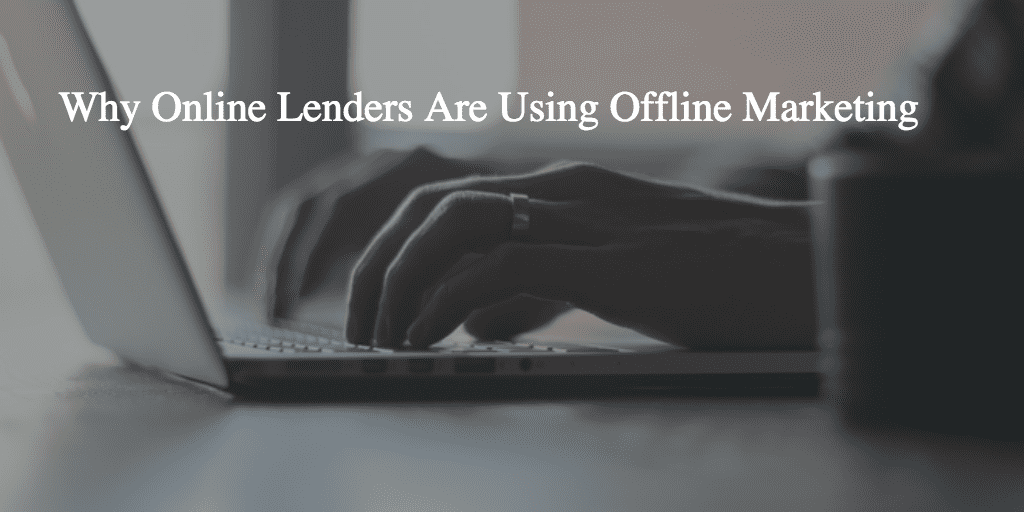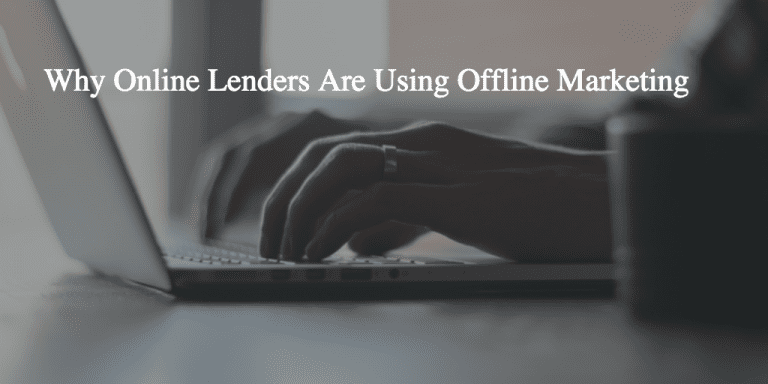
[Editor’s note: This is a guest post from Marc Prosser. Marc is the co-founder of FitBiz Loans, a loan brokerage site which assists small business owners and entrepreneurs around the country in obtaining financing. Marc is also the co-founder and publisher of popular small business educational site Fit Small Business, and prior to that, was the Chief Marketing Officer at online forex broker FXCM. Priyanka Prakash, a finance specialist at FitBiz Loans, also assisted in writing this article.]
Online marketplace lenders get a lot of credit for disrupting banks and making the slow, antiquated process of applying for a loan modern, fast, and electronic. However, we are now seeing more and more online marketplace lenders using old school offline marketing strategies, such as partnerships with traditional banking institutions and direct mail.
In this article, I explore this trend in more detail and explain why many marketplace lenders are focusing heavily on offline marketing.
The Dichotomy: Online Lenders Using Offline Marketing
When I think of online marketplace lenders like Lending Club, Prosper, and OnDeck, the first thing that comes to mind is how cutting edge they are. Their whole reason for being is that they took the antiquated process of applying for a loan and made it fast, easy, and online. They employ hundreds of engineers who have put together sophisticated underwriting algorithms, algorithms that analyze literally thousands of data points to make credit decisions.
One would think that online lenders who so heavily leverage automation would also focus their marketing efforts online, where they have instant access to detailed performance data. A closer look, however, shows that the leading players are focusing heavily offline and in particular on 2 areas:
- Partnerships. On the consumer side, last April, Lending Club teamed up with Citigroup to facilitate more than $150 million in loans to underserved markets. Around the same time, Prosper announced a partnership with more than 160 community banks. On the business side, OnDeck has teamed up with JP Morgan Chase to provide small dollar loans to small business owners. There are also noteworthy partnerships with non-banking institutions, such as the Lending Club-Alibaba partnership and OnDeck-Intuit partnership.
- Direct Mail. The Wall Street Journal reported that in July of last year, Lending Club mailed 33.9 million loan offers. That’s more than double what it sent in July 2014, indicating that the tactic has worked well for the company. During the same time, Prosper sent 20.2 million direct mail offers. OnDeck CEO Noah Breslow has also said that direct marketing is central to his company’s future.
What explains the irony of these cutting edge companies spending millions of dollars on old school marketing techniques?
One word: Targeting
Offline Marketing Allows Better Targeting of Qualified Borrowers
The Limitations of Online Marketing
All lenders face the same obstacle, which is that a large percentage of borrowers are not qualified for the loan they are applying for. More than half of Americans have subprime credit, making it much tougher for them to obtain a loan from lenders like Prosper and Lending Club, which focus on prime borrowers.
Business loan marketplace lenders face a double whammy. At my own company FitBiz Loans, we’ve found that only about 1 in 10 borrowers applying from keyword targeted (like SBA Loans) online ads have both good credit and a profitable business. In addition to wasted marketing spend, if only 1 in 10 leads are qualified, brokers and lenders also waste resources talking to people who do not fit their desired credit profile.
This is not to say that there are no successful targeting techniques available through online channels, but relative to offline channels, it’s limited. While both Google and Facebook are getting much better with allowing companies to target using demographic data, they offer nowhere near the level of granularity and specificity that you can achieve with offline marketing. For example, while you can target groups of people that fit a certain profile, say women aged 30-35, individual data is always hidden.
Also, Google and Facebook data is focused almost exclusively on the consumer side currently. It’s still in the early days for the business side of things, so what you can do there in terms of targeting is even more limited.
How Partnerships and Direct Mail Beat Online Marketing
By far the best way to target qualified borrowers is to work with a partner that does the filtering for you.
For instance, through the OnDeck-JP Morgan Chase partnership, OnDeck gets access to business owners with established businesses and good credit but who are unable to get a conventional bank loan because they want to borrow less than $250,000.
Bank loans are notoriously paperwork and time intensive for both the bank and the borrower. This fact, combined with increased regulatory scrutiny on banks, makes it unprofitable for banks to make smaller dollar loans. Online marketplace lenders like OnDeck got their start specifically by taking advantage of this pain point. Both the bank and OnDeck generally go through similar underwriting processes (amount of work) for a $50,000 loan and a $500,000 loan. The difference for OnDeck is that much of the underwriting process is automated, so borrowers looking for smaller amounts, like $50,000, are attractive potential clients.
Partnerships are also valuable because they target borrowers when they are in a ‘convertible’ state of mind. For example, Lending Club formed a partnership with Chinese e-commerce company Alibaba last year to allow American manufacturers to get business loans to purchase supplies from Chinese businesses. By marketing loans to small business owners while they are exploring options for how to fulfill purchase orders, Lending Club can more easily convert small business owners than they could with a more generic email campaign or online advertising.
While partnerships are most effective at targeting qualified borrowers, direct mail also allows a high level of targeting. On the consumer loan side of things, direct mail allows you to target based on a wide variety of variables, including geographic location, credit history, household income, and more. On the business loan side, you can also target size and type of business, profitability, age of business, and even whether the owner currently has a business loan or has had one in the past.
Of all these variables, at least on the consumer side of things, credit history is probably the most valuable from the lender’s point of view. The credit bureaus make available a wealth of credit information about more than 200 million consumers that the platforms can use to send out targeted direct mail campaigns. By focusing on specific credit subgroups, Lending Club and Prosper can better match investors and borrowers. For example, they might target super prime borrowers one month to cater to more risk averse investors and move down the credit spectrum the following month to cater to more risk taking investors. The ability to engage in this kind of dynamic targeting is the power of direct mail.
Bottom line
While marketplace lenders got their start by disrupting the banks, their future success may depend on strategic partnerships, direct mail, and other old school tactics. While some are pointing to these things as signs that marketplace lenders are ‘selling out,’ I think it’s a sign of marketplace lenders seeing the limitations of online marketing and looking for new, more effective ways to expand their customer base.
(Disclaimer: Marc Prosser, the author of this article, is the co-founder of FitBiz Loans / Fit Small Business, which has financial relationships with several of the lenders mentioned in this article).


